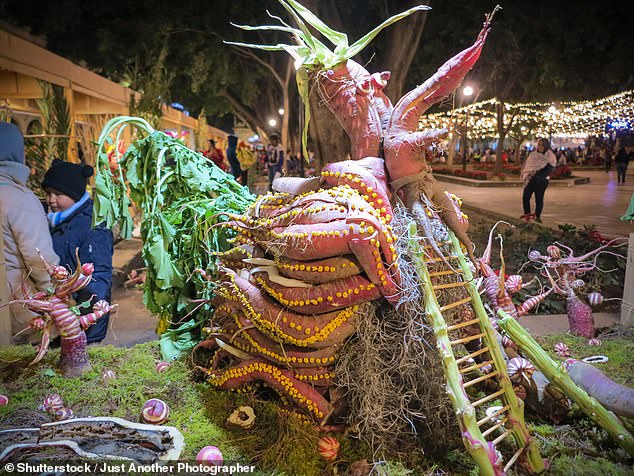Sleigh, what? From carving radishes to building giant goats – 10 weird and wonderful Christmas traditions around the world
It's the most wonderful time of the year.
And what better way to welcome it than with giant straw goats, fried caterpillars, radish carvings and decorated horse skulls.
These are just a few of the strange Christmas attractions featured in our list of 10 weird and wonderful festive traditions around the world.
Scroll down to learn more about the customs that involve exclaiming, “sleigh, what?”
Sweden – giant goat a go-go
The town of Gävle in Sweden is perhaps best known for being home to a giant straw goat. Founded every year around Christmas
Every year, a 13-meter-high straw goat is built on the castle square of Slottstorget in Gävle, Sweden.
It's a young tradition – only dating back to 1966 – and the structure is the brainchild of advertising consultant Stig Gavlén, who enjoyed constructing a version of the Swedish Yule Goat.
In addition to building the goat, a festive sub-tradition of attacking it has emerged. Since 1966, the massive structure has suffered an attempted kidnapping by helicopter, being run over by a car, and almost annual (illegal) attempts to set it on fire.
Another (less criminal) Scandinavian tradition is to tune into Sweden's main public television channel on Christmas Eve for an episode of Walt Disney's Donald Duck.
Mexico – Night of the Radishes

Forget carving the Christmas turkey: in Oaxaca, Mexico, the festivities start with the carving of radishes
In Oaxaca, Mexico, a radish carving competition known as “The Night of the Radishes” takes place every December.
The bizarre tradition dates back to 1897, a time when market traders made sculptures with their products to attract shoppers. Now thousands gather in the city's main square for the annual festival.
Competitors transform the oversized vegetable into fantastic scenes – often religious in nature – and compete for a cash prize.
Austria, Germany and Eastern Europe – Krampus

St Nick's evil competition, Krampus, appears around Christmas in Austria, Germany and Eastern Europe to scare mischievous youngsters
In many countries, people like Santa Claus or Sinterklaas arrive with gifts for children.
However, an ominous counterpart is emerging in Austria, Germany and parts of Eastern Europe.
It is said that a curious mix of half goat and half demon, Krampus, roams the streets brandishing a wicker basket in search of mischievous youths.
South Africa – fried caterpillar

In South Africa, fried emperor moth caterpillars are served as a starter on Christmas Day
Nothing says Christmas like deep-fried caterpillars.
Although it is more like a Bushtucker process, emperor moth caterpillars are cooked by South Africans on Christmas Day.
The crunchy snacks, Atlas Obscura notes, are said to be quite nutritious, with a taste reminiscent of tea.
Czech Republic – throwing shoes

Throwing shoes is a festive tradition in the Czech Republic, where the ritual indicates whether a marriage is possible
In the Czech Republic, it is believed that single women can predict whether they will get married in the coming year through a festive ritual that revolves around the tradition of throwing away shoes.
The shoe is thrown over the shoulder and if it lands with the heel towards the door, it is believed that the thrower will remain single. But if the toe is pointed at the door, wedding preparations could be underway.
To embrace the unique tradition, First choice recommends flying to Prague.
Italy – La Befana

St. Nick aside, La Befana, an ancient witch, is Italy's most popular gift giver. The photo shows people dressed as witch during a boat race in Venice called the 'Regatta of Befana'
In Italy, the end of the Christmas season is celebrated on January 6, the day of Epiphany.
The night before, La Befana, a friendly witch, brings sweets and goods to well-behaved children. While naughty children, instead of rewards, get pieces of coal, onions and garlic, or even a straw from her broom.
She wears a dark scarf and enters houses through the chimney – and children will leave food and wine for her.
Spain – red underwear

Many Spaniards will wear red underwear to welcome the new year
Although technically a New Year's tradition, Spanish Christmas lasts until January 5, and many welcome the New Year by wearing red underwear called 'Bragas Rojas'.
The unique end-of-year tradition is supposed to welcome good luck for the coming year.
In the village of La Font de la Figuera, close to Valencia, they even organize a Red Lingerie Run, where locals strip down to celebrate the New Year, whatever the weather.
Wales – Mari Lwyd

In Wales, a giant horse skull is carried from door to door on the occasion of Christmas. Photo courtesy of Creative Commons licensing
A well-known Welsh Christmas tradition, according to Wales.com, is Mari Lwyd, which means 'gray mare'. It is the name given to a giant horse skull, which is carried from door to door by a group of people playing music.
The skull is decorated with colorful streamers, lights or baubles, and a white cloak that hides a person.
Wales.com adds: 'You will never forget the moment you first see a Mari Lwyd.'
Guatemala – burning of the devil

This fiery holiday tradition in Guatemala involves people burning effigies of the devil – and their unwanted goods
Every year on the evening of December 7, Guatemalans build bonfires and burn effigies of the devil. The Christmas season begins with the fiery festivities.
The tradition known as 'La quema del diablo' also sees people clearing out their homes and throwing their unwanted goods onto the fire.
Finland – sunrise saunas

In preparation for the upcoming festivities, the Finns spend Christmas Eve in a sauna. And go back inside on Christmas Day
The Christmas sauna is one of the most traditional Finnish rituals.
According to saunafromfinland.comMany Finns have the habit of going to the sauna twice on Christmas Eve and Christmas Day.
The traditional Finnish sauna experience involves cooling down between sessions by taking a dip in cold pools or rolling in the snow.
